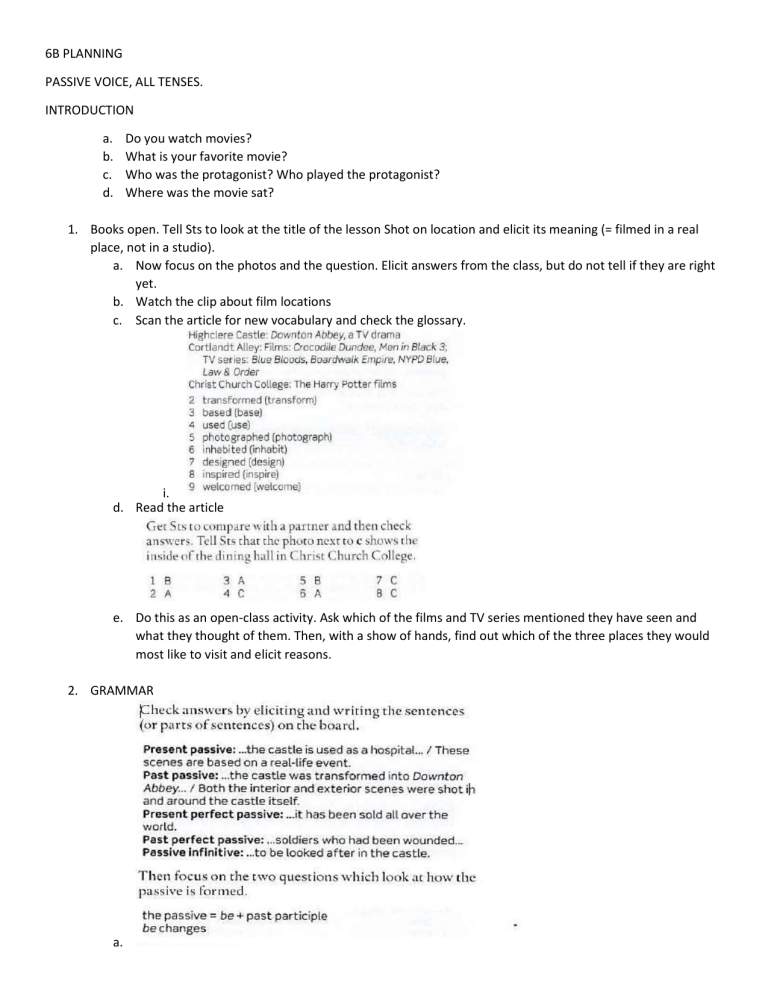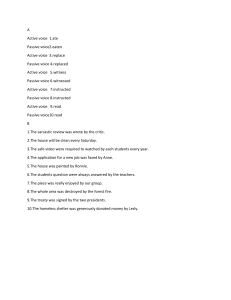
6B PLANNING PASSIVE VOICE, ALL TENSES. INTRODUCTION a. b. c. d. Do you watch movies? What is your favorite movie? Who was the protagonist? Who played the protagonist? Where was the movie sat? 1. Books open. Tell Sts to look at the title of the lesson Shot on location and elicit its meaning (= filmed in a real place, not in a studio). a. Now focus on the photos and the question. Elicit answers from the class, but do not tell if they are right yet. b. Watch the clip about film locations c. Scan the article for new vocabulary and check the glossary. i. d. Read the article e. Do this as an open-class activity. Ask which of the films and TV series mentioned they have seen and what they thought of them. Then, with a show of hands, find out which of the three places they would most like to visit and elicit reasons. 2. GRAMMAR a. b. c. Read the Highclere Castle text again. Underline all example of the present passive, the past passive, the present perfect passive, the past perfect passive, and a passive infinitive. How do you for the passive? What part of the passive changes when you want to change the tense? d. PG. 142 Grammar bank learn about the passive and practice it. 3. PRONUNCIATION a. 3.32) Focus on the cask and tell Sts that they are going to hear six passive sentences which they have to try to write down. The first time they listen they only need to write the stressed words. Play the audio for Sts just to hear the first sentence and focus on the example. b. c. Practice all tenses passive voice https://www.liveworksheets.com/yx16129hv, ask students to do them in a piece of paper or in the website 4. VOCABULARY a. Look atso1ne extracts fron1 the texts in What do you think the highlighted phrases mean? i. Cortlandt Alley has been used for almost all the alley scenes in films and TV series that are set in New York. ii. These scenes are based on a real-life event. iii. Both the interior and exterior scenes were shot in and around the castle itself. iv. Pg. 159 Vocabulary Bank: Cinema 1. KINDS OF FILMS a. Match photos with the kinds of film b. Listen and check c. Think of a famous film for each kind. d. What kind of films do you/do not you like? Why? 2. PEOPLE AND THINGS a. Match the noun and definitions. b. Check if students remember the meaning (quizzlet) 3. VERBS AND PHRASES a. Now play the audio for Sts to check answers. Give practice of any words your Sts find difficult to pronounce, modelling and drilling, as necessary. b. Explain the difference between these pairs of word s and phrases. i. a plot and a script ii. a horror film and a thriller iii. a musical and a soundtrack iv. the main cast and the extras 5. SPEAKING a. Read the cinen1a interview and think about your answers and reasons. 6. SPEAKING & LISTENING a. Look at the images from some famous films. What kinds of films are they? Have you seen any of them? What are they about? What do you think they have in common? b. Dagmara Walkovicz, who worked as an interpreter on one of his films. In pairs, answer the questions. i. I Where do you think they are? ii. Which Spielberg film do you think was being made? iii. What do you think Dagn1ara is doing in the photo on the right? iv. Do you think Dagmara found Spielberg easy to work with? c. 3.36. Listen to the first part of an interview with Dagmara and check your answers to b I and 2. d. Listen again and mark the sentences T (true) or F (false). e. 3.37) Now tell Sts they are now going to listen to the second part of the interview. They need to listen to check their answers to questions 3 and 4 in b. Play the audio once the whole way through. Get Sts to compare with a partner and then check answers. i. She is playing an extra in a party scene. ii. Yes, he was demanding, but very nice. f. g. Would you have liked to have done Dagmra's job? Do you think she n1ade the right decision in the end? h.


